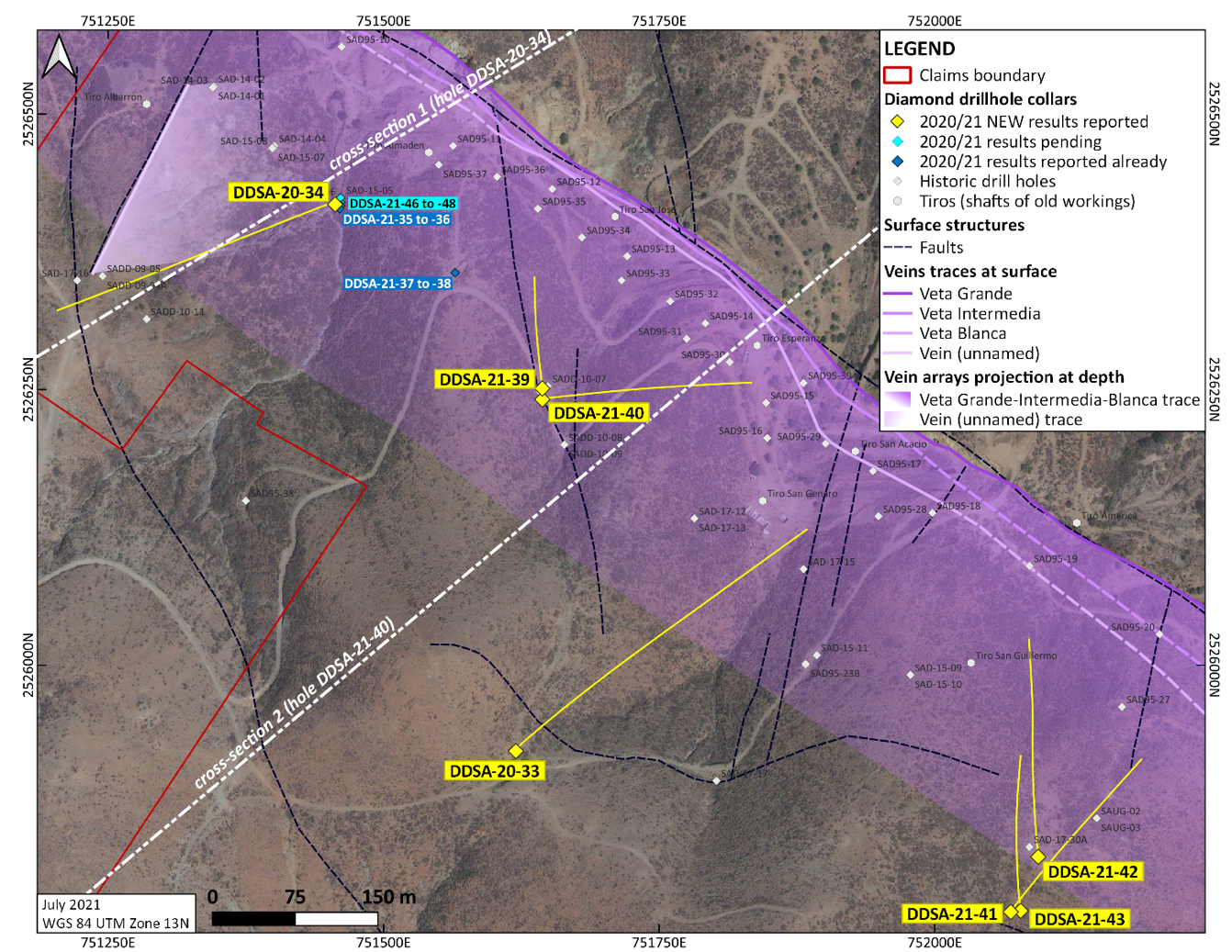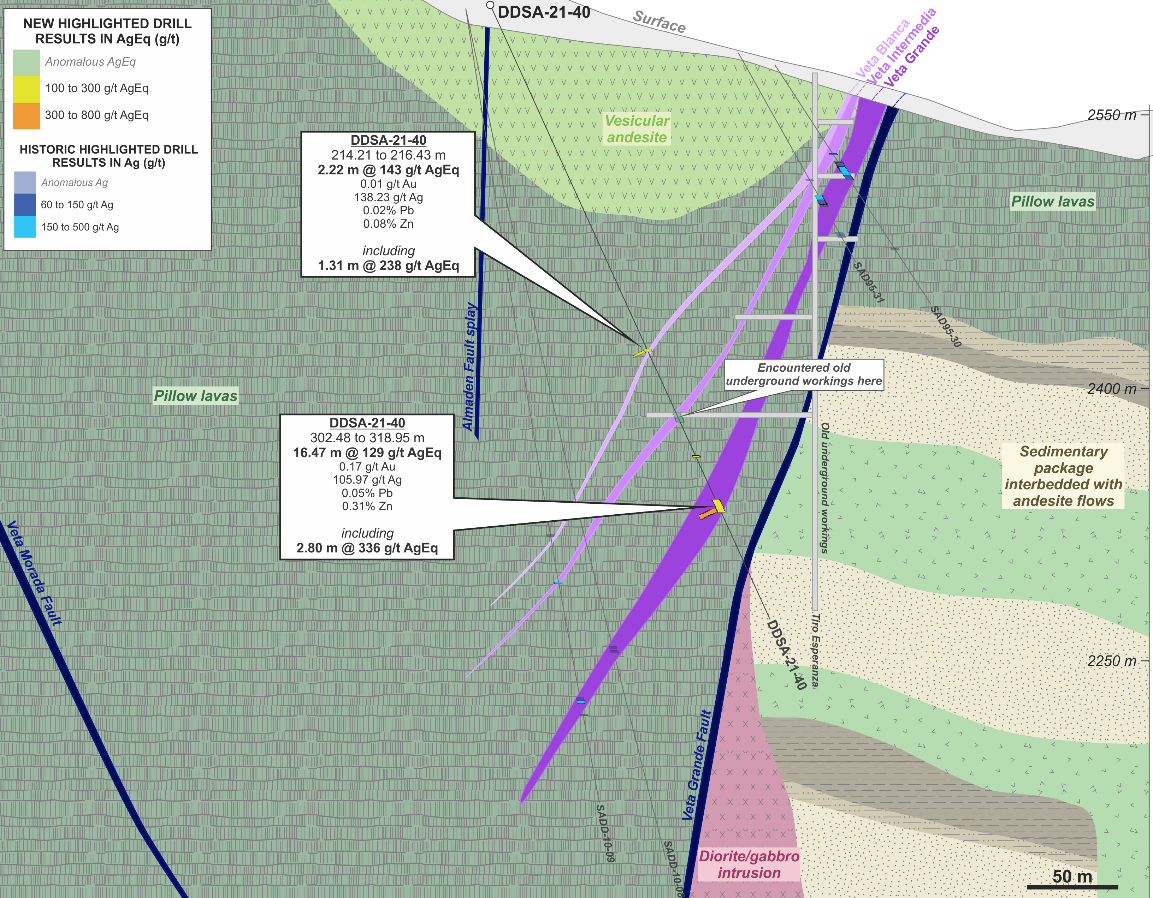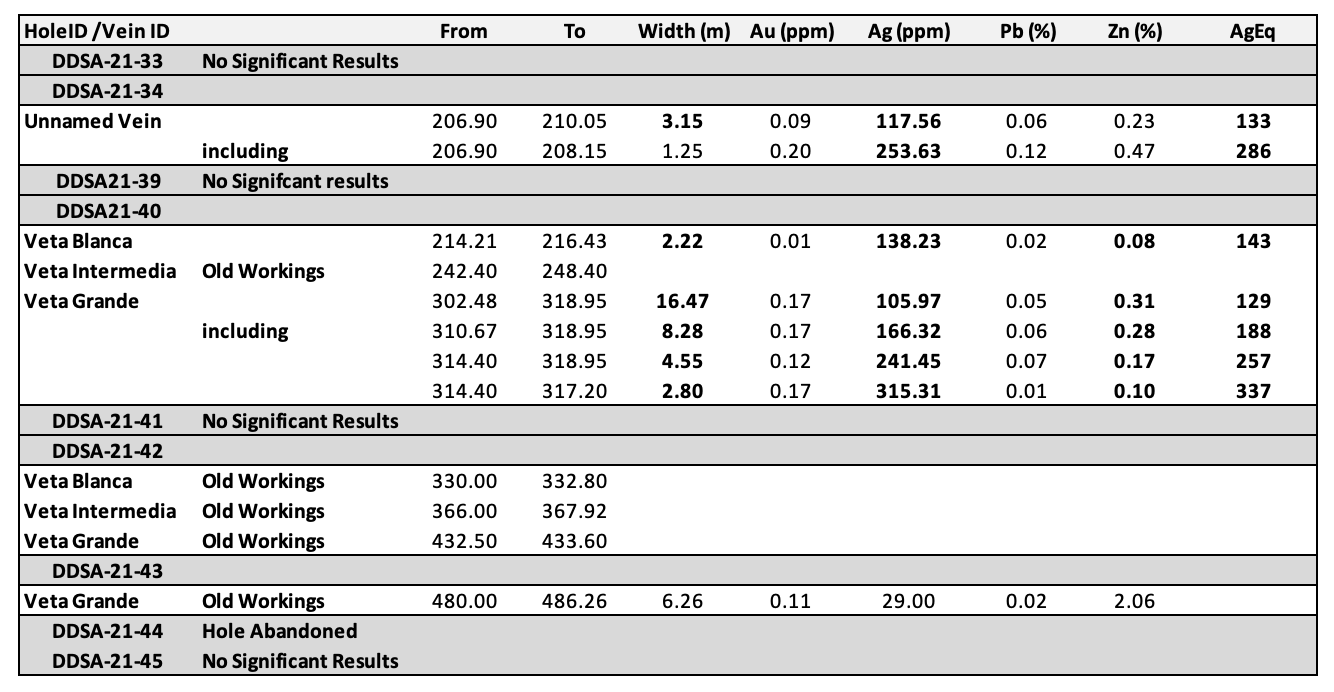Defiance Silver Corp. (“Defiance” or the “Company”) is pleased to provide an update to the ongoing drill program at the company’s Zacatecas project. The current phase of the drill program has been successful in defining a new zone of mineralization near the Veta Morada fault and further outlining wide zones of mineralization on the Veta Grande vein system at the Zacatecas project.
Highlight of Results
- DDSA-21-40 – Intersected high grade and wide widths of silver on the Veta Grande vein, including 2.8 metres of 336 g/t AgEq (from 314.40-317.20m) within an 8.28 metre wide zone of 188 g/t AgEq included in a wider interval of 16.47m of 129 g/t AgEq (from 302.48-318.95m).
- DDSA-21-34 – Was designed to test the Veta Morada fault at depth and intersected a new, unnamed vein with elevated Ag, Au, Pb, Zn results near the Veta Morada fault, including 1.25m (206.9-208.15m) of 253.63 g/t Ag, 0.20 g/t Au and 0.47 % Zn or 286 g/t AgEq. This was in a 3.10 metre wide zone (206.90-210.05m) of 133 g/t AgEq. This was the first hole into a newly identified structural zone.
Chris Wright, Chairman & CEO, commented: “We are encouraged by the discovery of a previously unrecognized silver-bearing vein system in a hanging wall structure that has never previously been tested. Furthermore, drill hole DDSA-21-40, a step out hole from the excellent results on hole DDSA21-36, returned encouraging grades and wide widths. Follow-up drilling in this zone will target the new mineralized vein at DDSA-21-36 and the mineralization in DDSA-21-40.”
Overview Maps

Figure 1 – Zacatecas project and reported drill holes in yellow.
Blue diamonds represent previously reported drill holes in current program. Light blue diamonds represent holes completed with results pending.

Figure 2 – Drill hole collar locations with Veta Grande and new unnamed vein projected to surface. Cross-section locations shown in white dashed lines.
Cross Sections

Cross Section 1 - Cross Section of drill hole DDSA-21-34 (Veta Morada area with the newly discovered unnamed vein). Previous reported results from hole DDSA-21-35 also highlighted.

Cross Section 2 - Cross section of drill hole DDSA-21-40 with highlighted intervals and location of old workings encountered on the Veta Intermedia.
Discussion of Results
Historical stopes and higher-grade mineralized intercepts appear to primarily occur at the intersections of north-striking faults and the Veta Grande vein system. The vein system looks to contain higher grades and wider intercepts of mineralization at these intersections, as evident by the presence of substantial underground workings, high-grade historical drill results, and wide widths with high metal grades encountered in the 2021 drill program (e.g. DDSA-21-36, 37).
Proof of concept exploration success: one drill hole into the Veta Morada area discovered a previously unrecognized hanging-wall vein system with multiple elevated precious and base metal intercepts.
The drill holes in this release were designed to test several targets at the San Acacio Project area:
- Test a previously undrilled vein system at San Acacio (Veta Morada fault zone).
- Test locations with different relationships to fault intersections to locate areas of increased mineralization and understand their controls.
- Discover and quantify the extent of historic workings and remaining in-situ mineralization.
Objective 1 – New Vein Zone
Hole DDSA-20-34 was the first hole collared to test the Veta Morada fault located to the south of the main Veta Grande structure. Drilling encountered a previously unknown vein that appears to be outboard of the Veta Morada fault and possibly related to northerly-striking faults that are perpendicular to the main Veta Grande fault trend. This unnamed vein has limited information and further drill programs will continue to follow up on and delineate this vein.
Objective 2 – Structural Controls on Grade-Thickness
Holes 33, 39, 40, and 45 were drilled on locations within the Veta Grande system that were untested by previous exploration drill holes. Hole DDSA-20-33 was the first hole drilled during this drill program. It was drilled deep underneath the system prior to the mapping team’s identification the potential controlling structures. This hole does intersect the three veins of the Veta Grande vein system; however, the veins are poorly mineralized in this location. Subsequent mapping has shown that this hole was drilled into the footwall of the north-striking, east-dipping faults that appear to control the mineralization in this area. Holes drilled into the hanging-wall of this same structure tend to have significant grade-thickness.
Likewise, hole DDSA-21-39 hit vein and breccia material at the predicted location; however, this hole appears to be too far from the north-striking faults that control the new mineralization announced in the last release (holes DDSA-21-36, 37 & 38). The vein is present in DDSA-21-39 but is silica-flooded and richer in lithics rather than polyphase breccia clasts. The vein does contain sulphide mineralization, but in lesser amounts than DDSA-21-36, 37 & 38. Sulphide content progressively decreases from 36 to 37 to 38 to 39 and appears to be controlled by proximity to another of these north-striking structures.
Following on this understanding, DDSA-21-40 was collared in the same location as DDSA-21-39 but drilled from the footwall into the hanging wall of a prospective north-trending fault. A large interval of substantial mineralization was encountered here. Historic miners did not penetrate this zone of the Veta Grande vein, though Veta Intermedia was mined in this location.
Hole DDSA-21-45 was a re-drill of hole DDSA-21-44, which was attempting to target the intersection of the Veta Grande structure and a north-striking fault farther to the east within the project area. Hole DDSA-21-44 experienced severe deviation, and the hole was abandoned and re-collared nearby as hole DDSA-21-45. Unfortunately, hole DDSA-21-45 experienced further deviation (+12 degrees) and failed to intersect the target.
Objective 3 – Extent of Historic Workings
Holes DDSA-21-41, 42, and 43 were drilled into the eastern extent of the most significant historical workings to understand the extent of mineralization and underground workings in this area. Hole DDSA-21-41 was drilled broadly parallel to and underneath the Refugio tunnel, confirming the lack of underground workings and the diminished sulphide content of the veins in this portion of the vein system.
Hole DDSA-21-42 was drilled directly into the area with the largest amount of historic workings mapped on the historic long-section and between two historic underground drill holes with moderate silver grades. Hole DDSA-21-42 encountered three different workings, including a set of deeper workings not shown on the historic long section of the mine.
Hole DDSA-21-43 targeted the intersection of a mapped north-striking fault and the projection of the Veta Grande vein; the portion of the vein targeted in this hole is down-dip from that of hole DDSA-21-42. Hole DDSA-21-43 encountered a large historic working (6+ metres) at the projection of the Veta Grande vein. These workings are not shown on any historic long sections or level plans, but the size of the working and tenor of the remaining mineralization indicates that the structural intersection that was targeted is productive for historically mineable mineralization.
San Acacio Geologic Overview
The highest-grade silver mineralization is typically associated with honey-coloured sphalerite, argentiferous galena, variable silver sulphides, and spatially correlated with amethyst. The highest-grade gold mineralization is typically associated with pyrite, brown to red-coloured sphalerite, and occasionally with hematite. The hanging-wall mineralization tends to express as a more conventional vein to veinlet array morphology while the Veta Grande often occurs as a breccia with vein-type textures and gangue.
San Acacio hosts a current Inferred mineral resource estimate containing 16.97 Moz silver (17.76 Moz AgEq) grading 181.94 g/t silver (192.5 g/t AgEq) with a 100 g/t AgEq cut off (see the Technical report titled: Technical Report and Resource Estimate, San Acacio Silver Deposit, Zacatecas State, Mexico by Giroux and Cuttle dated September 26, 2014, which is also available on Sedar and the company’s website here.
Long Section of Drilling

Figure 3 – Schematic long section showing Veta Grande intersections, limits of current resource estimate, and known underground workings.
Table of Results

Table 1 – Silver equivalent is calculated using the following formula: Silver-Equivalent (AgEq) = [(Au_ppm x 56.26)+(Ag_ppm x 0.80)+(Pb_ppm x .0016)+(Zn_ppm x 0.0026)]/0.80. Metal price assumptions are Au:$1750, Ag:$25, Pb: $0.75, Zn:$1.2. 100% recovery has been assumed for all metals.At this stage of the project, no metallurgy has been completed, and the reader is cautioned that 100% recoveries are never achieved. True thickness is assumed to be 50%-80% of downhole width.
Drill Hole Information

Table 2 – All coordinates in WGS84 UTM, Zone 13N.
The current drill program, a continuation of the previously numbered drill holes, commenced with hole DDSA-20-33.This news release contains the results from holes (DDSA-21-33, 34 and 39 to 45) for a total of approximately 4014.2 metres. The company has drilled approximately 7842 m of HQ3 drill core to date in the current program.
Next Steps
- Continued drilling in the main resource area at the San Acacio mine, designed to test the limits of the vein system for an updated resource estimate.
- Additional district-scale surface exploration, including mapping and sampling at the Lucita project is ongoing.
- Core re-logging of the historical drill holes is ongoing.
- Permits have been submitted for approval on additional exploration holes as a follow up to the property-wide surface geochemistry and mapping program at San Acacio.
- Permits have been submitted for approval for phase 1 drilling at Lucita.
Discussion of QAQC and Analytical Procedure
Samples were selected based on the lithology, alteration, and mineralization characteristics; sample size ranges from 0.25 – 2m in width. All altered and mineralized intervals were sent for assay. One blank, one standard, and one duplicate were included within every 20 samples. Standard materials are certified reference materials [CRMs] from OREAS and contain a range of Ag, Au, Cu, Pb, and Zn values. Blanks, standards, and duplicates did not detect any issues with the analytical results.
Samples were analyzed by ALS Chemex Laboratories. Sample preparation was performed at the Zacatecas, Mexico, prep facility, and analyses were performed at the Vancouver, Canada, analytical facility.All elements except Au and Hg were analyzed by a multi-element geochemistry method utilizing a four-acid digestion followed by ICP-MS detection [ME-MS61m]; mercury was analyzed after a separate aqua regia digest by ICP-MS. Overlimit assays for Ag, Pb, and Zn were conducted using the OG62 method (multi-acid digest with ICP-AES/AAS finish). Gold was measured by fire-assay with an ICP-AES finish [50g sample, Au-ICP22].
San Acacio History
Zacatecas State continues to be the top producer of silver in Mexico and is one of the reasons Mexico remains the world’s largest silver-producing region. The Zacatecas-Fresnillo Silver Belt is one of the most prolific silver producing areas in the world. Production at the San Acacio mine dates to at least 1548 when Spanish colonialists mined mainly bonanza oxide ores, typically grading in excess of 1kg/tonne Silver. The various veins were mined intermittently until the mid-1800s when an English company drove the ~2km Purisima tunnel to allow for deeper underground access and drainage. From the late 1800s until the Mexican Revolution in 1920, mining consisted of intermittent production from bonanza grade ores. During the Mexican Revolution, heavy fighting in the Zacatecas region led to the halt of most mining endeavors. In the mid 1920’s, a cyanide plant targeting silica rich ores and a floatation plant for complex Pb-Zn ores were built with varying success until the transition from oxide to sulphide rich ores made for recovery complexities. In the mid 1930s the first tonnage estimate was created on the property, although the project sat mostly idle save for some stope and adit rehabilitation at Purisima and Refugio. Production was largely dormant except for some small processing done by CIA Fresnillo in the late 1930s to early 1940s. In the mid-1990s Silver Standard Resources Inc. began a systematic exploration and evaluation program targeting an open pit silver mine consisting of backfill, remaining stopes and silica-rich hanging wall and footwall mineralization of the Veta Grande structure. This entry by a publicly-listed company kicked off nearly three decades of exploration, development, and bulk-scale processing.
Defiance Silver has been exploring the project since 2011 and has focused primarily on identifying near-term mine resources. Drilling by previous operators as well as Defiance Silver from 2009 to early 2017 confirmed the presence of significant mineralizing events that provide evidence for a long-lived mineralizing system. Drilling in late 2017 and early 2019 outlined complexities in the structural geology of the area and identified significant “down dropped” and rotated structural blocks as the company tested the Veta Grande at similar elevations where it was encountered by earlier mining and drilling.
About Defiance Silver Corp.
Defiance Silver Corp. (DEF | TSX Venture Exchange; DNCVF | OTCQX; D4E | Frankfurt) is an exploration company advancing the district-scale Zacatecas Project, located in the historic Zacatecas Silver District and the 100% owned Tepal Gold/Copper Project in Michoacán, Mexico. Defiance is managed by a team of proven mine developers with a track record of exploring, advancing and developing several operating mines and advanced resource projects. Defiance’s corporate mandate is to expand the San Acacio and Tepal projects to become premier Mexican silver and gold deposits.
Mr. George Cavey P.Geo., Vice President Exploration, is a Qualified Person within the meaning of National Instrument 43-101 and has approved the technical information concerning the Company’s material mineral properties contained in this press release.
On behalf of Defiance Silver Corp.
“Chris Wright”
Chairman of the Board
For more information, please contact: Investor Relations at +1 (604) 343-4677 or via email at info@defiancesilver.com.
Suite 2900-550 Burrard Street
Vancouver, BC V6C 0A3
Canada
Tel: +1 (604) 343-4677 Email: info@defiancesilver.com
Neither TSX Venture Exchange nor its Regulation Services Provider (as that term is defined in the policies of the TSX Venture Exchange) accepts responsibility for the adequacy or accuracy of this release.
This news release may contain forward-looking statements including but not limited to comments regarding timing and content of upcoming work programs, geological interpretations, receipt of property titles, potential mineral recovery processes, etc. Forward-looking statements address future events and conditions and therefore involve inherent risks and uncertainties. Actual results may differ materially from those currently anticipated in such statements. Defiance Silver Corp. relies upon litigation protection for forward-looking statements.